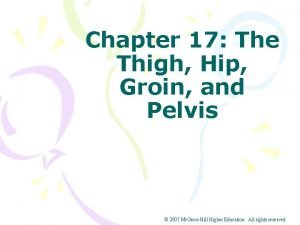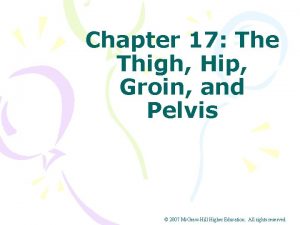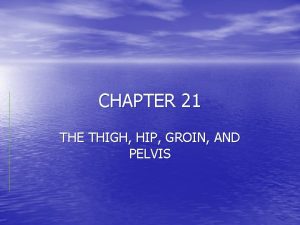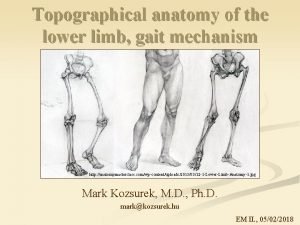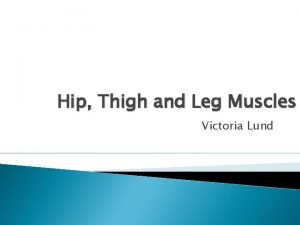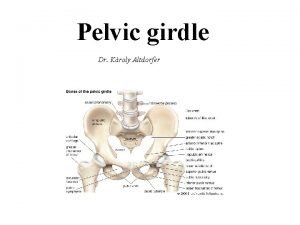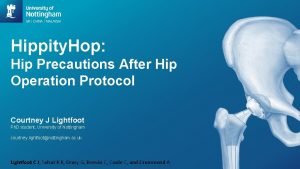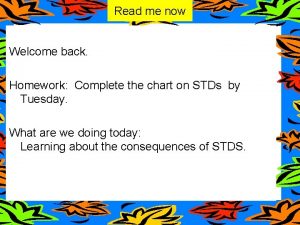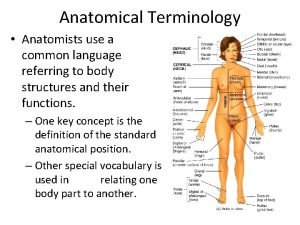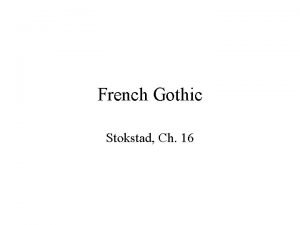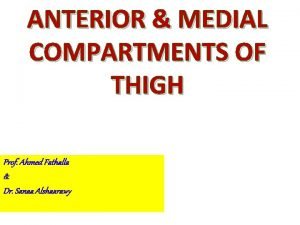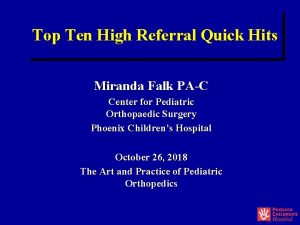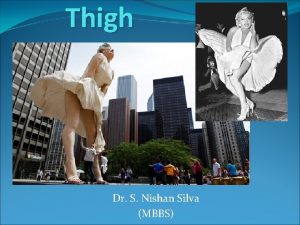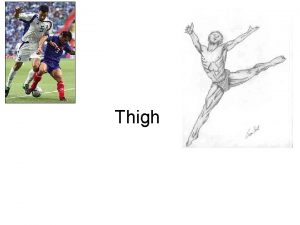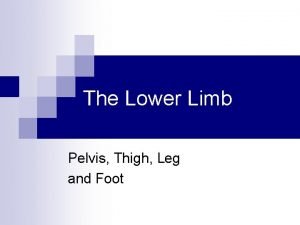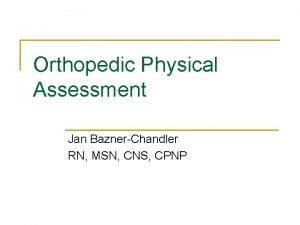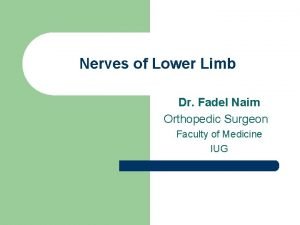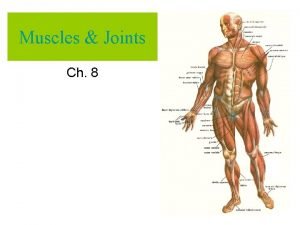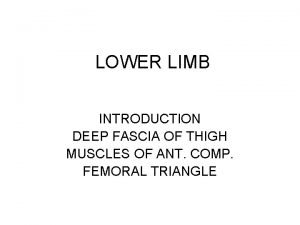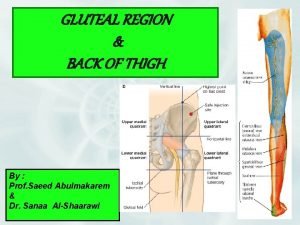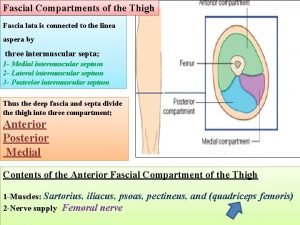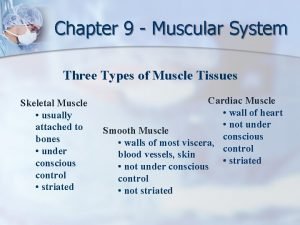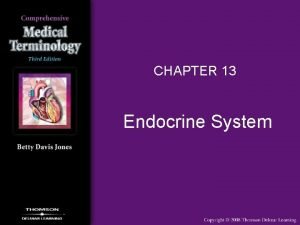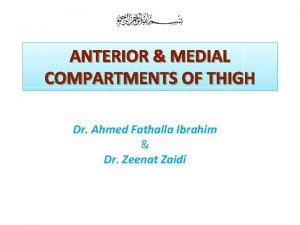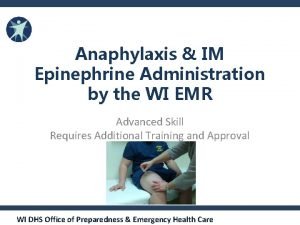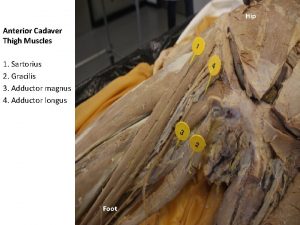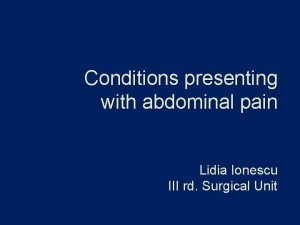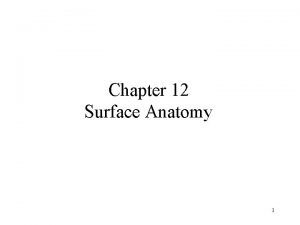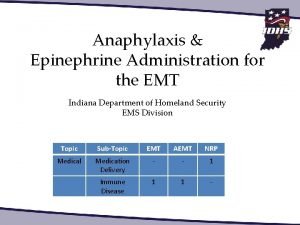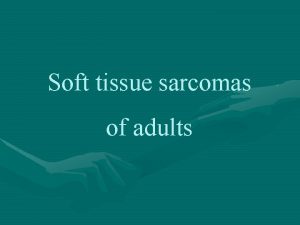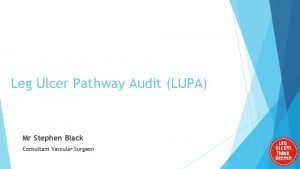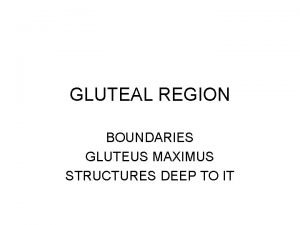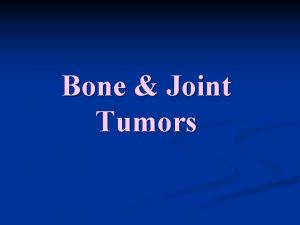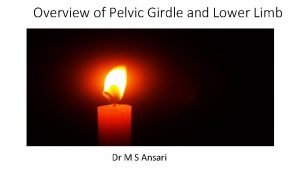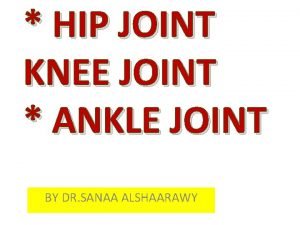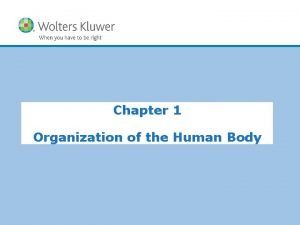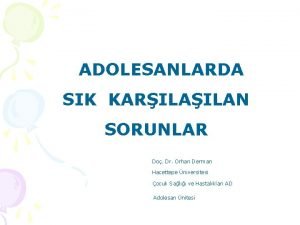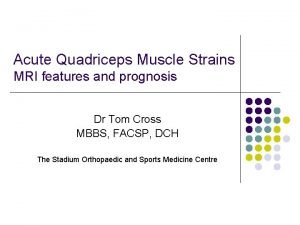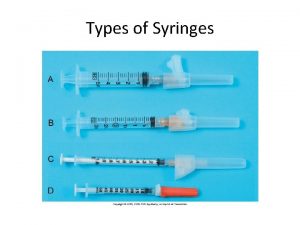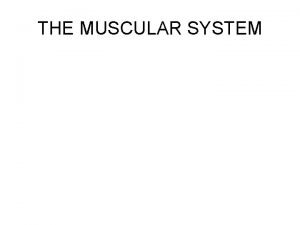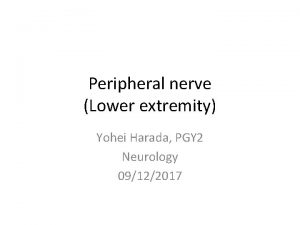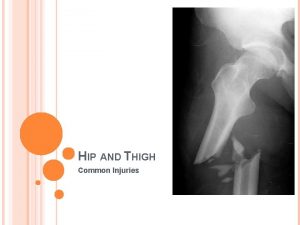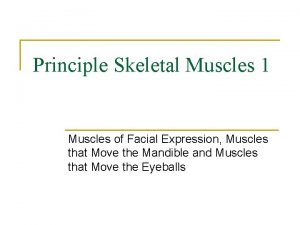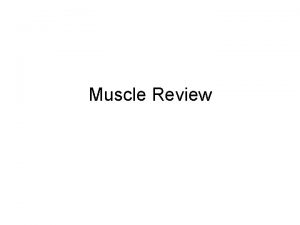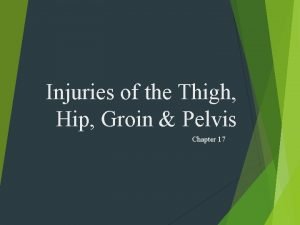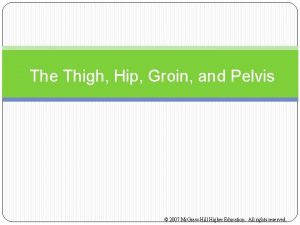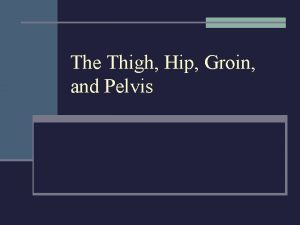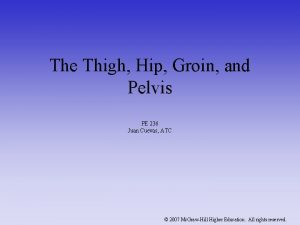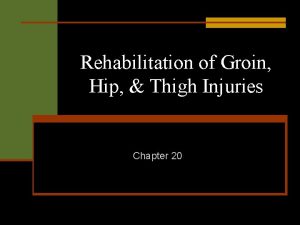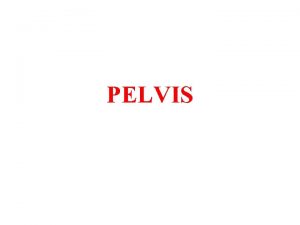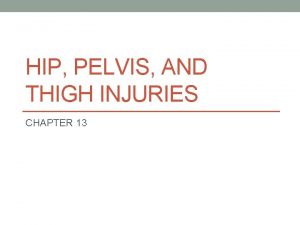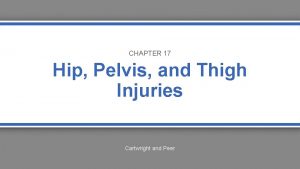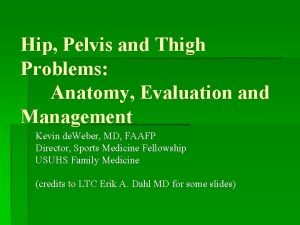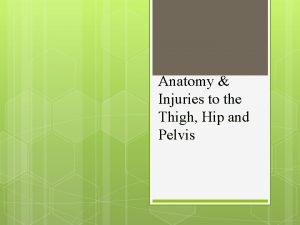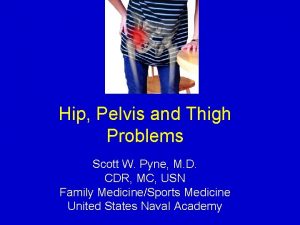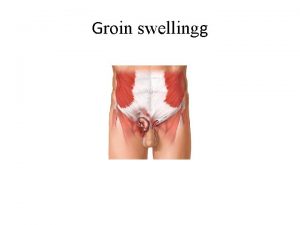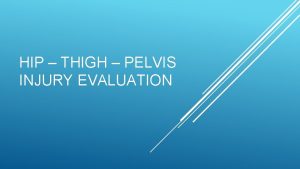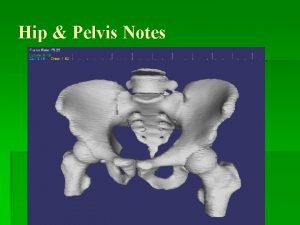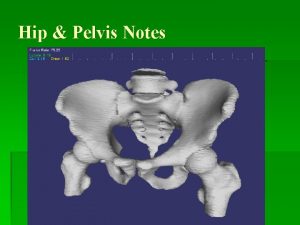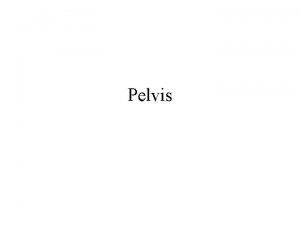CHAPTER 21 THE THIGH HIP GROIN AND PELVIS





























































- Slides: 61

CHAPTER 21 THE THIGH, HIP, GROIN, AND PELVIS

ANATOMY OF THE THIGH • Bones: Femur

THIGH MUSCLES • ANTERIOR THIGH: -Quadriceps: 4 muscles: -Rectus femoris, Vastus Medialis, Vastus Lateralis and Vastus intermedius. -Sartorius ** Action: Extension of leg

THIGH MUSCLES • POSTERIOR: -Hamstring: Biceps femoris, semitendonosus and semimembranosus **Action: Flexion of the leg

THIGH MUSCLES • MEDIAL: - Adductors - Pectineus - Gracilis Action: Adducts and laterally rotates the thigh


NERVE AND BLOOD SUPPLY • Nerves: Tibial, common Peroneal, and greater Sciatic nerve. • Blood: Femoral artery

HOPS OF THE THIGH • History: How, What and why • Observation: swelling, bruising, deformation, pain and ability to walk • Palpation: Bones-Greater Trochanter -Lesser Trochanter -Lateral and medial femoral condyle -Anterior superior iliac spine (ASIS)

PALPATION • SOFT TISSUE: - ANTERIOR: sartorius, Quad - POSTERIOR: Hamstring - MEDIAL: Adductors - LATERAL: Abuctors, Iliotibial band (ITB), Gluteus medius and tensor fasciae latae

SPECAL TESTS • ROM: Active, Passive, Resistive • Muscle weakness • Xrays: if fx is suspected

PREVENTION OF THIGH INJURIES • Conditioning • Strength • Endurance • Extensibility: ability to withstand strain • Collision sports: pads

THIGH INJURIES • Contusions: bruising • Myositis Ossificans Traumatica: blow to the thigh that causes ectopic bone production • Quadriceps Muscle strain • Hamstring Muscle strain • Acute Femoral Fracture • Femoral stress Fractures

THIGH CONTUSIONS

MYOSITIS OSSIFICANS TRAUMATICA

QUAD STRAIN HAMSTRING STRAIN

FEMORAL FRACTURE

FEMORAL STRESS FRACTURE

ANATOMY OF THE HIP, GROIN AND PELVIC REGION • BONES: Pelvis, Pelvic girdle, sacrum and coccyx.

LATERAL VIEW OF THE HIP

HIP JOINT • Ball in socket joint • Articulates with the femur and hip bone • Acetabulum: socket part of the joint • Greater trochanter: the head of the femur and is the ball of the joint

BALL AND SOCKET JOINT

LIGAMENTS OF THE HIP

MUSCLES OF THE HIP • ANTERIOR MUSCLES: - Iliacus: action: Assists in flexion - Psoas: action: Flexes thigh and trunk on the femur - iliopsoas: action: flexes trunk and hip • POSTERIOR MUSCLES: - Tensor fasciae latae: action: flexion, abduction and rotates thigh

MUSCLES OF THE HIP • POSTERIOR: - 3 Gluteal muscles: Maximus, medius and minimus. Action: Extends, abducts and medially rotates the thigh

BURSAE • Has many bursae. • Examples: iliopsoas bursae, greater trochanter bursae, and many others • Bursae are used to cushion the joint

BLOOD SUPPLY AND NERVES • NERVES: lumbar plexus, 4 th and 5 th lumbar nerves, 1 -3 sacral nerves, sciatic nerves, tibial and common peroneal nerves • BLOOD: Arteries: 2 common iliac arteries, internal and external iliac arteries • Veins: 3 major: found in the hip, groin and pelvis. Common iliac vein, internal iliac vein and external iliac vein


FUNCTIONAL ANATOMY OF THE HIP, GROIN AND PELVIS • Pelvis and hip: pelvic girdle • Articulates with the femoral head. -At the acetabulum (hip) with greater trochanter (femur) * Muscles include: Glutes, Quads, Hamstrings, Hip flexors and so on

HOPS • History: the how, what and why • Observation: Observe for postural asymmetry and while standing on one leg and during ambulation (recovery) • Palpation: -Boney: Iliac crest, ASIS, AIIS, Greater trochanter, Pubic symphysis, Ischial tuberosity, PIIS and PSIS

HOPS • Palpation: soft tissue - Quads, Ham, Gracilis, Abductors, Sartorius, Iliopsoas, Glutes, ITB, and Tensor fasciae latae. • Special Tests: -ROM -Tests for hip flexor tightness: Kendall test Thomas test Femoral Anteversion and retroversion

KENDALL TEST

Thomas Test

Femoral Anteversion (A) and Retroversion (B) – Relationship between neck and shaft of femur – Normal angle is 15 degrees anterior to the long axis of the femur and condyles – Internal rotation in excess of 35 degrees is indicative of anteversion, 45 degrees of external rotation is an indicator of retroversion

TESTS FOR HIP AND SACROILIAC JOINT • Patrick test (FABER) • Galenslen’s test • • TESTIN THE TENSOR FASCIAE LATAE AND ITB: Renne’s Test Nobel’s Test Ober’s test Trendlelenburg’s test Piriformis test Ely’s test

PATRICK’S TEST

• Test for Hip and Sacroiliac Joint • Patrick Test (FABER) – Detects pathological conditions of the hip and SI joint – Pain may be felt in the hip or SI joint

• Gaenslen’s Test – Test works to push SI joint into extension – Test is positive if hyperextension on affected side increases pain

Testing the Tensor Fasciae Latae and Iliotibial Band • Renne’s test – Athlete stands w/ knee bent at 30 40 degrees – Positive response of TFL tightness occurs when pain is felt at lateral femoral condyle

• Nobel’s Test – Lying supine the athlete’s knee is flexed to 90 degrees – Pressure is applied to lateral femoral condyle while knee is extended – Pain at 30 degrees at lateral femoral condyle indicates a positive test

• Ober’s Test – Used to determine presence of contracted TFL or IT-band – Thigh will remain in abducted position, not falling into adduction

OBER’S TEST

Trendelenburg’s Test - Iliac crest on unaffected side should be higher when standing on one leg - Test is positive when affected side is higher indicating weak abductors (glut medius)

• Piriformis Test – Hip is internally rotated – Tightness or pain is indicative of piriformis tightness

MEASURING LEG-LENGTH DISCREPANCY • Leg length discrepancies of more than 1 inch can cause symptoms • 1/8” may cause symptoms in highly active athletes. • Areas that may be affected: lower limbs (shins), hip and pelvis or lower back. • 2 types of leg length discrep: 1. true or anatomical shortening 2. apparent or functional shortening.

TYPES OF LEG LENGTH DISCREPANCY • Anatomical: may be equal throughout the lower limbs. • Functional: can occur as a result of lateral pelvic tilt or from flexion or adduction deformity.

Leg Length Discrepancy Measures

HIP, GROIN AND PELVIC INJURIES • Groin strain: muscle(s) strains • Trochanter Bursitis: inflam of burseas • Sprains of the hip joint • Dislocated hip joint: Greater trochanter out of • • • acetabulum Avascular Necrosis: loss of blood flow Legg-Calve-Perthes Disease (coxa plana) Snapping Hip Phenomenon: instablility of ligaments in the hip

GROIN STRAIN

TROCHANTER BURSITIS

DISLOCATION OF THE HIP JOINT

AVASCULAR NECROSIS

LEGG-CALVE-PERTHES DISEASE

PELVIC CONDITIONS • Hip Pointer: contusion to the iliac crest • Osteitis Pubis: Pull of muscles from the pubis. Common in runners • Athletic Pubalgia: Chronic pubic region pain. • Stress Fx • Avulsion Fx and apophysitis: Inflam of the apophyses of the hip

HIP POINTER

OSTEITIS PUBIS

AVULSION FRACTURES AND APOPHYSITIS

THIGH AND HIP REHAB • General conditioning • Flexibility • Mobilization • Strength • Neuromuscular Control • Functional Progression • Return to Activity

STRETCHING

STRENGTHENING EXERCISE

CORE STRENGTH EXCERISES

Balance Shoe for Neuromuscular Control
 Chapter 17 the thigh hip groin and pelvis
Chapter 17 the thigh hip groin and pelvis Chapter 17 the thigh hip groin and pelvis
Chapter 17 the thigh hip groin and pelvis Femoral anteversion
Femoral anteversion Hiatus subinguinalis
Hiatus subinguinalis Hip thigh and leg muscles
Hip thigh and leg muscles Minor pelvis
Minor pelvis Poem about hip hop
Poem about hip hop Hip hop hip the hippity
Hip hop hip the hippity Temperature
Temperature Superficial inguinal lymph node drainage
Superficial inguinal lymph node drainage Groin
Groin Directional terminology
Directional terminology French gothic art
French gothic art Floor of femoral triangle
Floor of femoral triangle Thigh foot angle
Thigh foot angle Femeral vein
Femeral vein Where is thigh located
Where is thigh located Adductor magnus insertion
Adductor magnus insertion Thigh foot angle
Thigh foot angle Tibial nerve innervation
Tibial nerve innervation Skeletal muscle
Skeletal muscle Amphiarthroidal
Amphiarthroidal Muscles of thigh cross section
Muscles of thigh cross section Deep fascia of thigh
Deep fascia of thigh Thigh region
Thigh region Compartments of thigh
Compartments of thigh Active muscle
Active muscle Thigh royd
Thigh royd Head body parts
Head body parts Thigh muscles medial
Thigh muscles medial How to draw up epinephrine
How to draw up epinephrine Thigh muscles cadaver
Thigh muscles cadaver Flexed thigh
Flexed thigh Shoulder surface anatomy
Shoulder surface anatomy Anterolateral thigh injection site
Anterolateral thigh injection site Hypertrohpic scar
Hypertrohpic scar Thigh lupa
Thigh lupa Gluteal region boundaries
Gluteal region boundaries Thigh sarcoma
Thigh sarcoma Mid inguinal point
Mid inguinal point Ankle jerk
Ankle jerk Hip extension vs flexion
Hip extension vs flexion Label the body regions with the proper adjective.
Label the body regions with the proper adjective. Pussy balls
Pussy balls Thigh
Thigh Sik
Sik Anterior thigh
Anterior thigh Landmarking ventrogluteal
Landmarking ventrogluteal Intrinsic foot muscles
Intrinsic foot muscles Knee extension nerve
Knee extension nerve Muscles innervated by obturator nerve
Muscles innervated by obturator nerve Thigh contusion
Thigh contusion Brachioradialis
Brachioradialis Mongolian spot
Mongolian spot Abducts the thigh
Abducts the thigh Hát kết hợp bộ gõ cơ thể
Hát kết hợp bộ gõ cơ thể Frameset trong html5
Frameset trong html5 Bổ thể
Bổ thể Tỉ lệ cơ thể trẻ em
Tỉ lệ cơ thể trẻ em Chó sói
Chó sói Chụp phim tư thế worms-breton
Chụp phim tư thế worms-breton Chúa sống lại
Chúa sống lại
